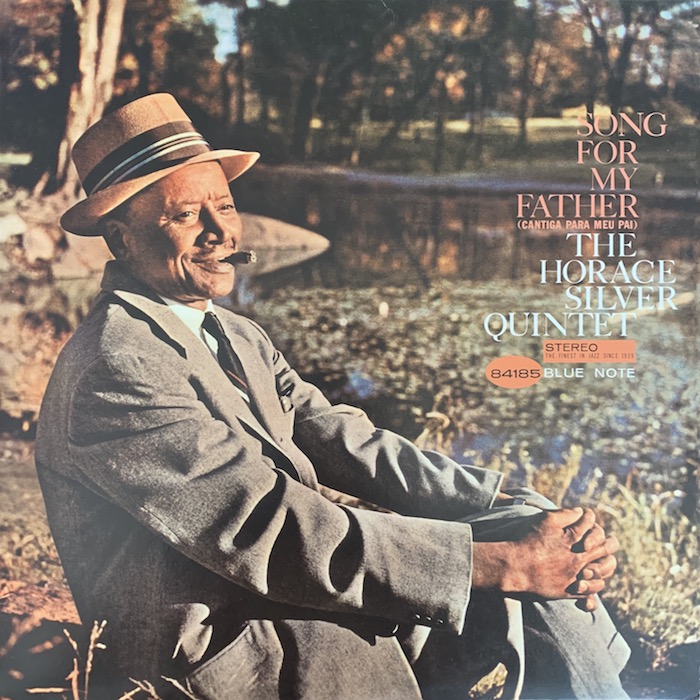
In October 1963, coinciding with the recent release of his debut album as leader on Blue Note, a young Joe Henderson was scouted by influential pianist Horace Silver to play in a new quintet he was putting together. From the sessions which followed came Song For My Father (1965), Silver’s most famous album and a bona fide Blue Note classic.
Following a trip to Brazil, Silver recorded this album as a tribute to his father John Tavares Silver, a photo of whom was used for the album cover. This album showcases Silver’s talents as a player, composer and arranger and sees him blend energetic, bluesy hard bop with influences from the Cape Verdean folk music of his father and Brazilian bossa nova. A hard bop and soul jazz pioneer, Silver was known for his talents as a composer and penned many compositions which have consequently become jazz standards – ‘The Preacher’, ‘Senor Blues’, ‘Sister Sadie’, ‘Nica’s Dream’, ‘Filthy McNasty’, ‘Doodlin’ and ‘Peace’ are some of his best known. With the exception of Henderson’s ‘The Kicker’, all the tracks on Song For My Father are Silver originals.
After co-founding the pioneering hard bop outfit The Jazz Messengers with Art Blakey in the early 50s, Silver went on to write and record with a quintet. Silver was greatly inspired by big band arrangement and applied this to writing for small combo playing. As writer Martin T. Williams notes in his book Jazz Changes (1993), Silver’s compositions and arrangements were designed to make his lineup sound larger than a quintet. Song For My Father saw Silver transitioning from his old band with Blue Mitchell and Junior Cook, to a newer, younger quintet featuring Carmell Jones (trumpet), Joe Henderson (tenor sax), Teddy Smith (bass) and Roger Humphries (drums).
The album’s title track ‘Song For My Father’ (‘Cantiga Para Meu Pai’ in Portuguese) is Silver’s most famous composition and since its release, has been covered more than 180 times. Dedicated to his Portuguese father who came from the Cape Verde Islands, the track was inspired by Silver’s memories of his childhood where his father and uncle used to throw ‘musical parties’ which Silver remembers fondly in the liner notes as ‘happy, informal sessions’. With its bossa nova feel and groovy bass ostinato, the track highlights Silver’s characteristic funky, percussive and upbeat play style. To quote writer Derek Walmsley, Silver was a ‘musical boxer’ who treated the piano as a punch bag. When once asked earlier in his career to describe his sound, Silver defined it as ‘that old-time gutbucket barroom feeling with just a taste of the backbeat.’
As for the other compositions on the album, the band never put a foot wrong. After the cool bossa of the album’s opener, the band launch into the driving ‘The Natives Are Restless Tonight’, one of my personal Silver favourites and a track where Henderson and Silver’s soloing abilities really shine. The sultry ‘Calcutta Cutie’ follows, featuring Silver and his old band. At times, the melody takes on a modal, Eastern tinge reminiscent of Yusef Lateef’s album Eastern Sounds. For ‘Que Pasa’, Silver and his quintet lock into a relaxed and bluesy groove before ramping up the tempo for the blistering hard bop of ‘The Kicker’, a horn led composition which sees this young lineup in full swing and features an excellent drum solo from Roger Humphries. The album closes with the beautiful ballad ‘Lonely Woman’ which features Silver alongside old bandmates Gene Taylor (bass) and Roy Brooks (drums). Despite being a moody and sombre composition for the most part, a hint of Silver’s playful style comes through at the end of the track where the trio tease the ending before playing one final refrain.
Silver once famously remarked that he strived for ‘simplicity with depth’ in his writing and Song For My Father illustrates this concept perfectly. As jazz critic Peter Keepnews has observed: “Mr. Silver emphasized melodic simplicity over harmonic complexity; his improvisations, while sophisticated, were never so intricate as to be inaccessible.”
With the longest career of any Blue Note artist (28 albums), Horace Silver was hugely influential as both a player and composer. An inquisitive character, Silver was prolific and continued composing until the end of his life. As he once remarked: “Music is everywhere, man. You just have to keep your ears open for it and have an open mind.” (Silver was even once inspired by the sound of his kettle and wrote ‘Serenade To A Tea Kettle’). In the later years of his career, Silver became an ardent believer in the capacity for music to heal and in the therapeutic properties of jazz:
“I may be prejudiced, but I believe that jazz music has the strongest healing potential, and it’s not just because I play it and love it so much. I feel that it’s the improvisation in jazz that makes it so strong as a healing tool, what each individual gives to a tune from their heart and their soul when they take a solo. It’s all spontaneous, and it’s all love, and from the heart.”
In the liner notes for his 1968 album Serenade To A Soul Sister, Silver argues that ‘musical composition should bring happiness and joy to people and make them forget their troubles.’ Maybe then during these uncertain and turbulent times, more people should be listening to Dr. Silver.
For more of that healing feeling, dive into our ‘Kings Of The Keys’ playlist over on Spotify.
If you enjoyed this post and want to stay updated, make sure to subscribe to our Spotify playlist and follow us on Instagram and Twitter!
